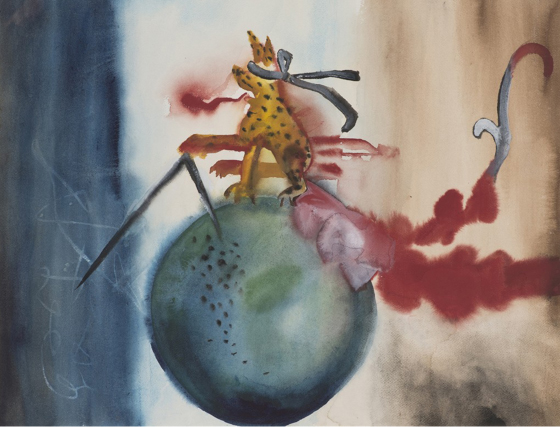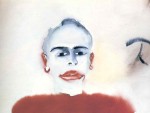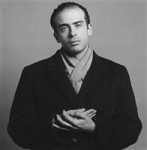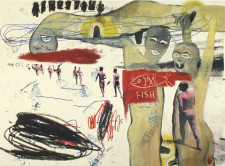Salman Rushdie – Being Francesco Clemente



Francesco Clemente
Italian, 1952- (active India, USA)
Untitled, 1983
watercolor on paper
18 x 23 7/8 in.
SBMA, Gift from the Collection of Laura Lee W. Woods
1991.184.2

Francesco Clemente, 1982 Photograph by Robert Mapplethorpe for Interview Magazine, and a self-portrait, above left, from the same year. Also a photograph by Gianfranco Gorgoni titled "Francesco Clemente and detail of General Animal (1984).
“Since the work is an image, you can’t tell where it began, and you forget where you began. So what you see there, I don’t know myself. I made a safe; I invented the safe, and I lost the key. And losing the key makes the work, gives the work this autonomy. It cannot be reduced. It cannot be brought back to its original elements. That makes it objectively poetical.”
(Crone in Crone/Marsh, p. 42)
RESEARCH PAPER
Francesco Clemente’s career as an artist began with poetry. His parents published a collection of his juvenile poems when he was twelve. Being born in Naples, Italy, he had been well-schooled in the Classics since childhood. At age eighteen he moved to Rome to study architecture but left before completing the program to focus on art. Concentrating on figurative works on paper, his first solo exhibition was at the Galleria Valle Guilia in Rome in 1971.
During the 1970s Clemente began a series of migrations between Italy, India, and America. From his studios in Rome, Madras, and New York he observed the special character, history and geography of each locale. “The richly layered and diverse cultures of all these places inform his imagery, which is dense with strange metamorphoses and fragmentations reflecting his immersion in a kind of world culture that bridges ancient and modern, East and West.”
(Jacobowitz, p.1)
Our untitled watercolor of 1983 was painted in New York. It measures 18” x 23 7/8”, the horizontal, oblong shape perhaps meant to be unrolled like a scroll. A yellow, dog-like creature is poised atop a large blue and green ball, one outstretched paw resting on the apex of a two-pronged tool. A tongue of fiery red paint issues from the animal’s mouth, while more fumes stream along its back and erupt into flaming jets. Spewing out from beneath the creature, two plumes of red-hot smoke twist and then glide off the painting’s edge. Interrupting Clemente’s basic palette of primaries is a gray knotted scarf, the ends flying in the breeze, that blindfolds the animal’s eyes. Black spots on the creature and dark dots on the ball punctuate the picture.
No linear perspective here, but the large circle shows deliberate 3-dimensional mass. With complete control of his brush and the thin, fluidity of watercolor, Clemente applies shaded strokes of dark and light blue that model the surface of the ball and imitate the reflection of light from its rounded, sphere-like surface. The green shape in its center adds visual fuel to the hot red plumes and at the same time keeps the blue ball steady and cool.
Art critic, Robert Hughes, describes what the 1980’s brought to American Art, ….”the relaxation of a tense, linear idea of modernist progress into a swarming of recycled styles in a field that included everything and its opposite.” (Hughes, p. 598) The tenets of minimalist, process, and conceptual art of previous decades were rejected and by reviving figuration and symbolism, the artists aimed to restore myth, mystery and magic to contemporary art. Clemente eschewed specific labels, preferring to create art forms uniquely his own. “I think about art, not about art systems.” Francesco Clemente, 1981. (Kellein, p. 25)
Clemente often refers to 1983 as a crucial year for himself in New York….”a peak time when artists, poets, writers, and musicians shared in a remarkable consummation of energy and creativity”. (Foye in Percy/Foye, p. 115) That year he began collaborations with Beat poet, Allen Ginsberg. After meditating on his poems, Clemente would begin painting and decorating the pages, often using watercolors. It was also the year he became friends with Andy Warhol and Jean-Michel Basquiat and they worked together on a group of 12 paintings using acrylic, silkscreen, and oil crayon on canvas. (Hackett, p. 502) Clemente has employed a variety of mediums throughout his career, e.g.: watercolor and pastel on paper; oil paint on canvas, linen or wood; egg tempura for creating frescoes. For him, “all techniques are the same in a sense. The movement of the brush through all different techniques is exactly the same”. (Crone in Crone/Marsh, p. 49)
Is there a key to deciphering this painting? Suppose this is a self-portrait with Clemente metamorphosed into a spotted, pointy-eared dog. He often painted portraits of himself in animal disguise. This time he might represent the constellation Canis Major dominated by the star Sirius, known as the Dog Star, most brilliant one in the entire sky. Manilius, Greek poet and astrologer, said Sirius “barks forth flame and doubles the burning heat of the Sun”.
(Ridpath, p. 2)
Clemente paints himself blindfolded, a reference to Eastern philosophy which defines wisdom as Insight, the mind turned in upon itself. Western logic considers wisdom as Vision, the mind gazing outward. (Foye in Percy/Foye, p. 50) Clemente rides blindly on Earth’s spinning orb, traveling from daylight to evening, guided by the moves of a two-legged compass. The shorter leg has pierced the earth in many places while the longer one’s pointed tip writes calligraphic messages on a midnight-blue sky. Clemente-dog, fueled by creative passion, connects the dots of past experience and channels his inner sight for new inspiration.…the next discovery to be shared in his next work.
Francesco Clemente is poetic, nomadic, eclectic, enigmatic and elusive. “He is a metamorph par excellence and as slippery as the legendary Old Man of the Sea.” (Rushdie, p. 2) Pausing to ponder in front of this painting was precisely his intent.
Prepared for SBMA Docent Council by Joan Dewhirst, 2013.
Bibliography
Crone, Rainer. Marsh, Georgia. “An Interview with Francesco Clemente”. 1987.
Elizabeth Avedon Editions, Vintage Contemporary Artists. Random House, Inc., N.Y.
Hackett, Pat, ed. “The Andy Warhol Diaries”. 1989. Warner Books, Inc., N.Y.
Hughes, Robert. “American Visions: the epic history of art in America”. 1997.
Alfred A. Knopf, Inc., N.Y.
Jacobowitz, Ellen. Percy, Ann. “New Art on Paper; Acquired with Funds from the Hunt Manufacturing Co”. Philadelphia Museum of Art. Exhibition Catalogue, 1988.
Kellein, Thomas, ed. “The 80s Revisited, from the Bischofberger Collection”. 2010.
DuMont-Buchverlag, Germany.
Percy, Ann. Foye, Raymond. “Francesco Clemente Three Worlds”. Philadelphia Museum of Art, 1990. Exhibition Catalogue, October 20-December 23, 1990. Italy.
Ridpath, Ian. “Star Tales”. www.ianridpath.com/startalescanismajor.htm
Rushdie, Salman. “Being Francesco Clemente”. From an essay originally published as
Salman Rushdie, “Being Francesco Clemente: in “Francesco Clemente: Self Portraits”. Exhibition Catalogue, 2006. Gagosian Gallery, N.Y.

Friends, Fransisco Clemente, Andy Warhol and Jean-Michel Basquiat worked together on a group of 12 paintings using acrylic, silkscreen, and oil crayon on canvas in 1984.
